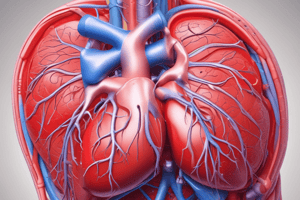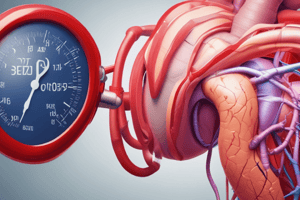Podcast
Questions and Answers
Which of the following is NOT a key role that the nervous system plays in the control of the cardiovascular system?
Which of the following is NOT a key role that the nervous system plays in the control of the cardiovascular system?
- Regulating long-term changes in blood pressure through renal mechanisms (correct)
- Redistribution of blood flow to various tissues throughout the body
- Producing rapid changes in systemic blood pressure
- Variations in cardiac rate and contractility
What is the primary effect of parasympathetic stimulation on the heart?
What is the primary effect of parasympathetic stimulation on the heart?
- Has little effect on contractility
- Increases heart rate
- Decreases heart rate (correct)
- Increases contractility
Which of the following statements about the autonomic innervation of the heart is NOT correct?
Which of the following statements about the autonomic innervation of the heart is NOT correct?
- Parasympathetic fibers have little or no distribution to the ventricles
- The right stellate ganglion primarily innervates the anterior epicardial surface and interventricular septum
- Parasympathetic fibers are primarily distributed to the SA node and AV node
- The left stellate ganglion primarily increases heart rate without affecting contractility (correct)
Which of the following is a key component of the intermediate (minutes-hours) regulation of arterial pressure?
Which of the following is a key component of the intermediate (minutes-hours) regulation of arterial pressure?
What is the primary location of the CNS vasomotor center?
What is the primary location of the CNS vasomotor center?
What is the primary effect of sympathetic stimulation on the heart?
What is the primary effect of sympathetic stimulation on the heart?
What is the mechanism believed to mediate vasodilation arising from the motor cortex?
What is the mechanism believed to mediate vasodilation arising from the motor cortex?
Which area of the brain plays a key role in modulating the activity of the vasomotor center?
Which area of the brain plays a key role in modulating the activity of the vasomotor center?
What initiates the baroreceptor reflex response via the vagus nerve?
What initiates the baroreceptor reflex response via the vagus nerve?
Which receptors have the highest concentrations at the carotid bifurcation and aortic arch?
Which receptors have the highest concentrations at the carotid bifurcation and aortic arch?
What results from activation of the stretch receptors in Levy's baroreceptor reflexes?
What results from activation of the stretch receptors in Levy's baroreceptor reflexes?
What is the normal HR response expected during a Valsalva maneuver in autonomic dysfunction testing?
What is the normal HR response expected during a Valsalva maneuver in autonomic dysfunction testing?
Which part of the central nervous system is responsible for modulating the activity of the vasoconstrictor area?
Which part of the central nervous system is responsible for modulating the activity of the vasoconstrictor area?
What is the primary mechanism by which sympathetic stimulation causes vasoconstriction?
What is the primary mechanism by which sympathetic stimulation causes vasoconstriction?
Which subtype of the alpha-1 adrenergic receptor is primarily responsible for mediating vasoconstriction?
Which subtype of the alpha-1 adrenergic receptor is primarily responsible for mediating vasoconstriction?
What is the role of the sensory area within the vasomotor center?
What is the role of the sensory area within the vasomotor center?
Which of the following is NOT a mechanism by which sympathetic stimulation can cause vasoconstriction?
Which of the following is NOT a mechanism by which sympathetic stimulation can cause vasoconstriction?
What is the role of the continuous slow firing of impulses from the vasoconstrictor area?
What is the role of the continuous slow firing of impulses from the vasoconstrictor area?
What is the purpose of the Valsalva ratio?
What is the purpose of the Valsalva ratio?
What is the normal range for the heart rate response to standing ratio?
What is the normal range for the heart rate response to standing ratio?
At which beat after standing is the relative bradycardia most marked?
At which beat after standing is the relative bradycardia most marked?
What is the normal mean difference in heart rate during deep breathing?
What is the normal mean difference in heart rate during deep breathing?
How is the blood pressure response to standing measured?
How is the blood pressure response to standing measured?
What is the primary role of the baroreceptor mechanism?
What is the primary role of the baroreceptor mechanism?
How do chemoreceptors primarily respond to changes?
How do chemoreceptors primarily respond to changes?
What effect does atrial stretch due to increased blood volume have on renal arterioles?
What effect does atrial stretch due to increased blood volume have on renal arterioles?
What is the primary impact of increased right-sided filling pressure on heart rate according to the Bainbridge reflex?
What is the primary impact of increased right-sided filling pressure on heart rate according to the Bainbridge reflex?
In the CNS ischemic response, what occurs when there is a decrease in blood flow to the vasomotor center?
In the CNS ischemic response, what occurs when there is a decrease in blood flow to the vasomotor center?
What physiological response does the Valsalva maneuver induce upon forced expiration against a closed glottis?
What physiological response does the Valsalva maneuver induce upon forced expiration against a closed glottis?
Flashcards are hidden until you start studying


